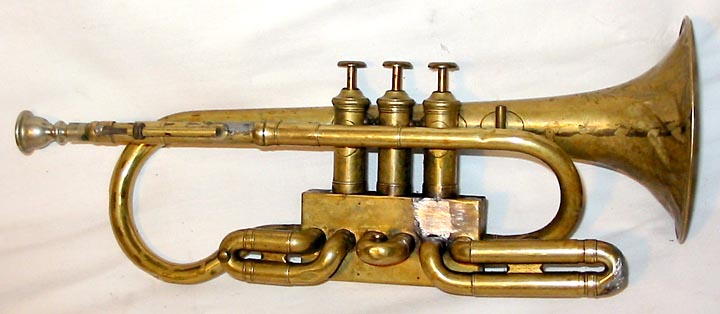Hall & Quinby Trombone with Box Valves
I saw this valve trombone listed on Ebay a few years back. There are only a small handful of box valve instruments by Hall & Quinby known to exist, making it quite a prize for many collectors to go after. Benjamin F. Quinby was granted a patent on this valve mechanism in 1872. Interestingly, they are somewhat similar to some of the earliest valve mechanisms made in Germany in the 1820s and it is hard to see the improvement over other valves used at the time. I assume that explains why they are so few of them extant.
This trombone was in very good original condition, without the usual damage that we must deal with in our rare instruments. One major condition problem was present, however: all three valve pistons and the valve cover were missing. Not surprisingly, it sold for a price that was too high for almost any other valve trombone. A few months later I got a phone call from Steve Dillon, who was the lucky winner, asking me what I would charge to make the missing parts. I didn't have much basis for quoting a price, but I threw out a high figure and agreed to put it on my waiting list.
When the time came, he sent it right off to me and I had to make a plan. I contacted Tim Holmes, who has a close relationship with the musical instrument collection at the Henry Ford Museum. He was able to provide photographs of a Quinby Bros. Bb cornet in that collection with the same valve design although actuated by a system very similar to what Isaac Fiske called "key pistons" as seen in Jeff Stockham's Eb cornet shown in the last photo. These photos showed details of the design that were important to reproduce for Steve's trombone.
I was able to find tubing of the correct size and cut and drilled the rectangular pieces from thick sheet brass. These were carefully silver soldered together, resulting in valves with slightly larger dimensions than needed in the finished valves. The original valve casings have never been damaged and careful measuring revealed that the sides were tapered. The pistons had to be machined to a perfect fit resulting in an airtight seal. I was very concerned that I would have difficulty measuring the taper and then making the cuts accurately enough on my old, worn milling machine. To make the extremely fine surface with tight tolerances, a machine must be extremely well maintained without wear in the spindle or ways.
I consulted my good friend, Hermann Knechtle, who is an extremely talented machinist that makes molds for aerospace clients. Lucky for me, Hermann also loves antiques and history and wanted to take on this project. It turned out to be an easy job for him. He is accustomed to making extremely accurate measurements of angles and keeps his machines in perfect working order at all times. He returned these parts to me fitting almost perfectly. Only the lightest lapping made them move freely while still being airtight. For more explanation and demonstration of this trombone, check out Steve Dillon's video featuring it.






